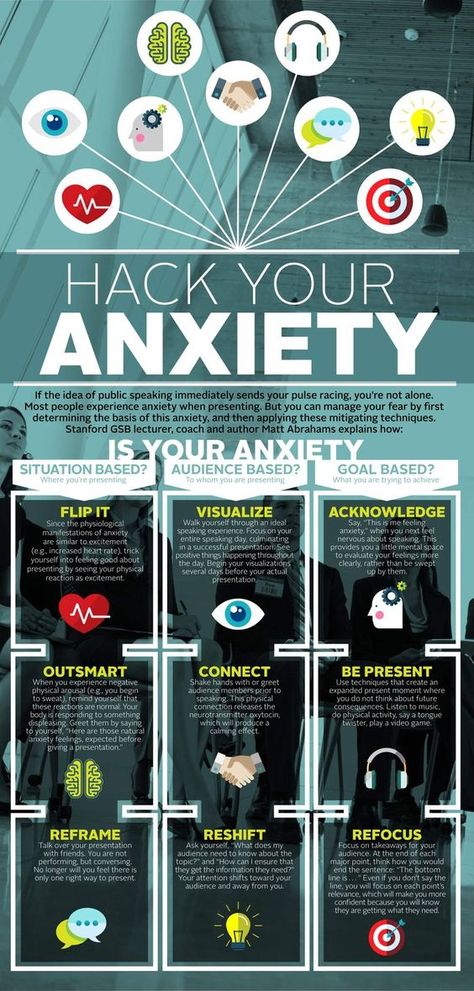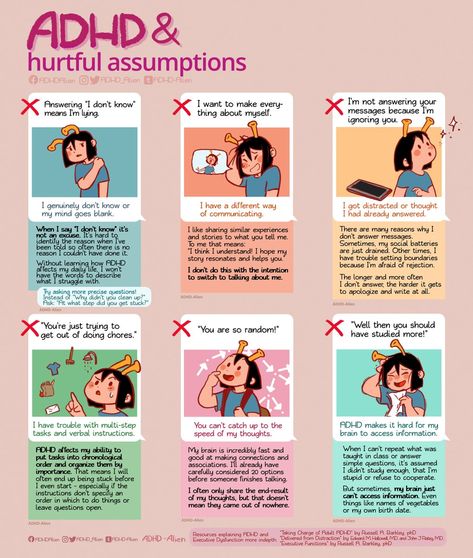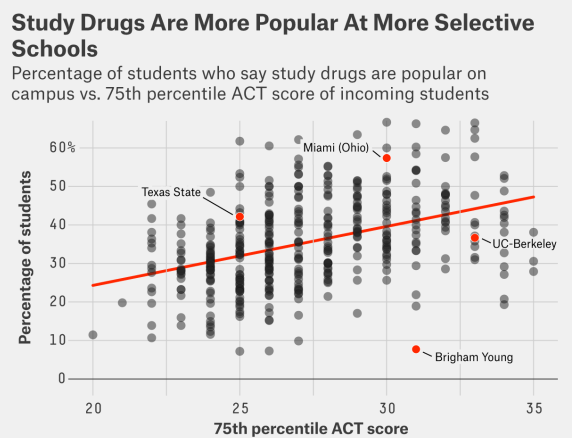Physiological signs of anxiety
What Does It Feel Like?
If you have anxiety, you might frequently feel worried, nervous, or afraid about ordinary events. These feelings can be upsetting and difficult to manage. They can also make daily life a challenge.
Anxiety can also cause physical symptoms. Think about a time when you felt anxious. Maybe your hands were sweaty or your legs were shaky. Your heart rate might have sped up. You could have felt sick to your stomach.
You might have linked these symptoms to your nervousness. But maybe you weren’t sure why you felt unwell.
Most people experience anxiety on occasion. Anxiety can be serious or turn into a disorder if it lasts for a long time, causes significant distress, or interferes with your life in other ways.
Types of anxiety include:
- panic disorders
- generalized anxiety disorder (GAD)
- separation anxiety
- social anxiety
- phobias
- obsessive-compulsive disorder (OCD)
Some types of anxiety have unique symptoms specific to the fears linked to the anxiety. In general, though, anxiety disorders share many physical symptoms.
Read on to learn more about anxiety’s physical symptoms and how they can affect you.
Anxiety can have physical symptoms that affect health and daily life.
Physical symptoms of anxiety
- stomach pain, nausea, or digestive trouble
- headache
- insomnia or other sleep issues (waking up frequently, for example)
- weakness or fatigue
- rapid breathing or shortness of breath
- pounding heart or increased heart rate
- sweating
- trembling or shaking
- muscle tension or pain
Specific types of anxiety might have additional physical symptoms.
If you’re having a panic attack, you might:
- fear that you’re going to die
- have trouble breathing or feel as if you’re choking
- have numb or tingling sensations in parts of your body
- have chest pain
- feel lightheaded, dizzy, or as if you might pass out
- feel overheated or have chills
Anxiety, the body’s response to stress, is how your body alerts you to threats and helps you get ready to deal with them. This is called the fight-or-flight response.
This is called the fight-or-flight response.
When your body responds to danger, you breathe rapidly because your lungs are trying to move more oxygen through your body in case you need to escape. This can make you feel as if you’re not getting enough air, which could trigger further anxiety or panic.
Your body isn’t meant to always be on alert. Being in constant fight-or-flight mode, which can happen with chronic anxiety, can have negative and serious effects on your body.
Tensed muscles may prepare you to get away from danger quickly, but muscles that are constantly tense can result in pain, tension headaches, and migraines.
The hormones adrenalin and cortisol are responsible for increased heartbeat and breathing, which can help when facing a threat. But these hormones also affect digestion and blood sugar.
If you’re often stressed or anxious, frequently releasing these hormones can have long-term health effects. Your digestion may also change in response.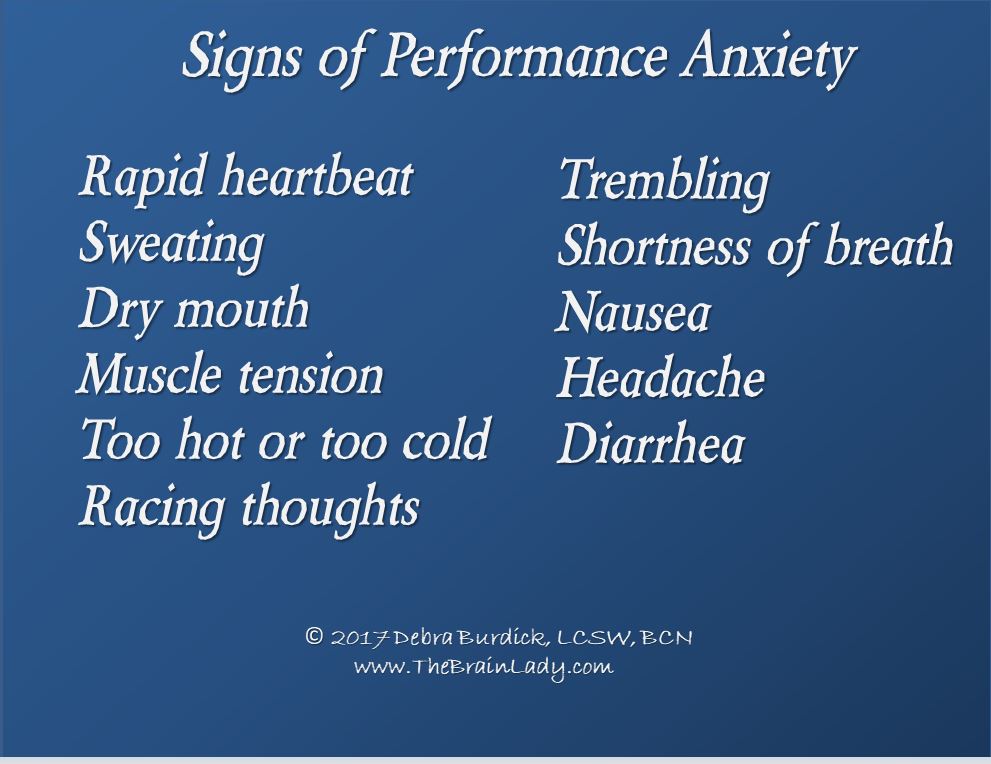
If your symptoms affect your mental health or make everyday life difficult, it’s a good idea to see a doctor. Your primary care provider can rule out medical issues that cause the same symptoms.
If your physical symptoms have no medical cause, you could have anxiety. A mental health professional can diagnose anxiety and other mental health conditions.
While there’s no medical test for anxiety, there are screening tools a psychiatrist, psychologist, therapist, or counselor may use to help determine if you have anxiety.
A mental health professional will ask you about all of your symptoms, physical and emotional, to determine whether you have an anxiety disorder. They’ll also want to know how long you’ve had symptoms and if they’ve increased in severity or were triggered by a specific event.
There are important facts to share with your therapist:
- Are you using drugs or other substances?
- Have you been hurting yourself or are you having thoughts of hurting yourself or others?
Either of these things can impact diagnosis and treatment.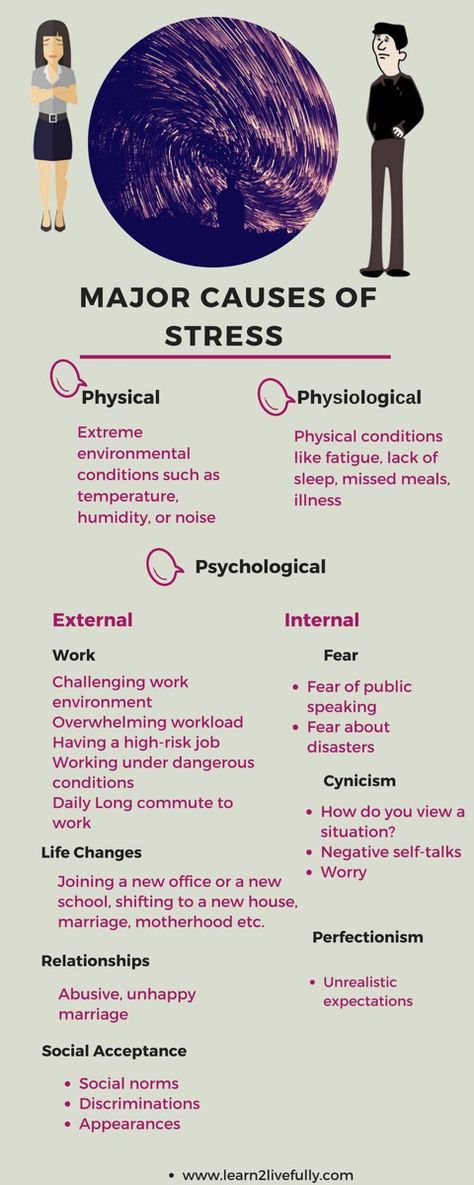 Many people have anxiety along with another mental health condition, such as depression. Telling your therapist about all of your symptoms can help you get the most accurate diagnosis and most helpful treatment.
Many people have anxiety along with another mental health condition, such as depression. Telling your therapist about all of your symptoms can help you get the most accurate diagnosis and most helpful treatment.
According to the Anxiety and Depression Association of America (ADAA), you may be at increased risk for physical health problems if you have anxiety.
A 2015 study of 989 adults found that anxiety symptoms were associated with ulcers. The same study also found that as anxiety and depression symptoms increased, it became more likely a person would have:
- asthma
- heart problems
- migraines
- vision problems
- back problems
Research has further linked asthma and anxiety. A 2016 study suggested that either asthma or anxiety can cause or result from the other.
Research has also suggested that anxiety is associated with an increased risk for heart disease, heart failure, and stroke, though it hasn’t been determined that anxiety is a specific risk factor for these conditions.
A 2017 study of older adults found that anxiety was associated with heart disease. Having both anxiety and depression was linked to an increase in vision problems, stomach problems, and asthma, among other issues.
Because anxiety can have such a serious impact on health, it’s important to get help. Mild anxiety may go away on its own or after the event causing the anxiety is over, but chronic anxiety often persists and may get worse.
If you aren’t sure how to find a therapist, you can ask your primary care provider for a referral.
Therapist directories can also help you locate a therapist in your area. If you think you have anxiety, you can look for providers who specialize in anxiety treatment.
Finding Help For Anxiety
- ADAA Online Support Group
- Crisis Text Line: Text CONNECT to 741741
- SAMHSA: Help finding treatment in your area
- ADAA therapist directory
Treatment for anxiety depends on what symptoms you have and how severe they are.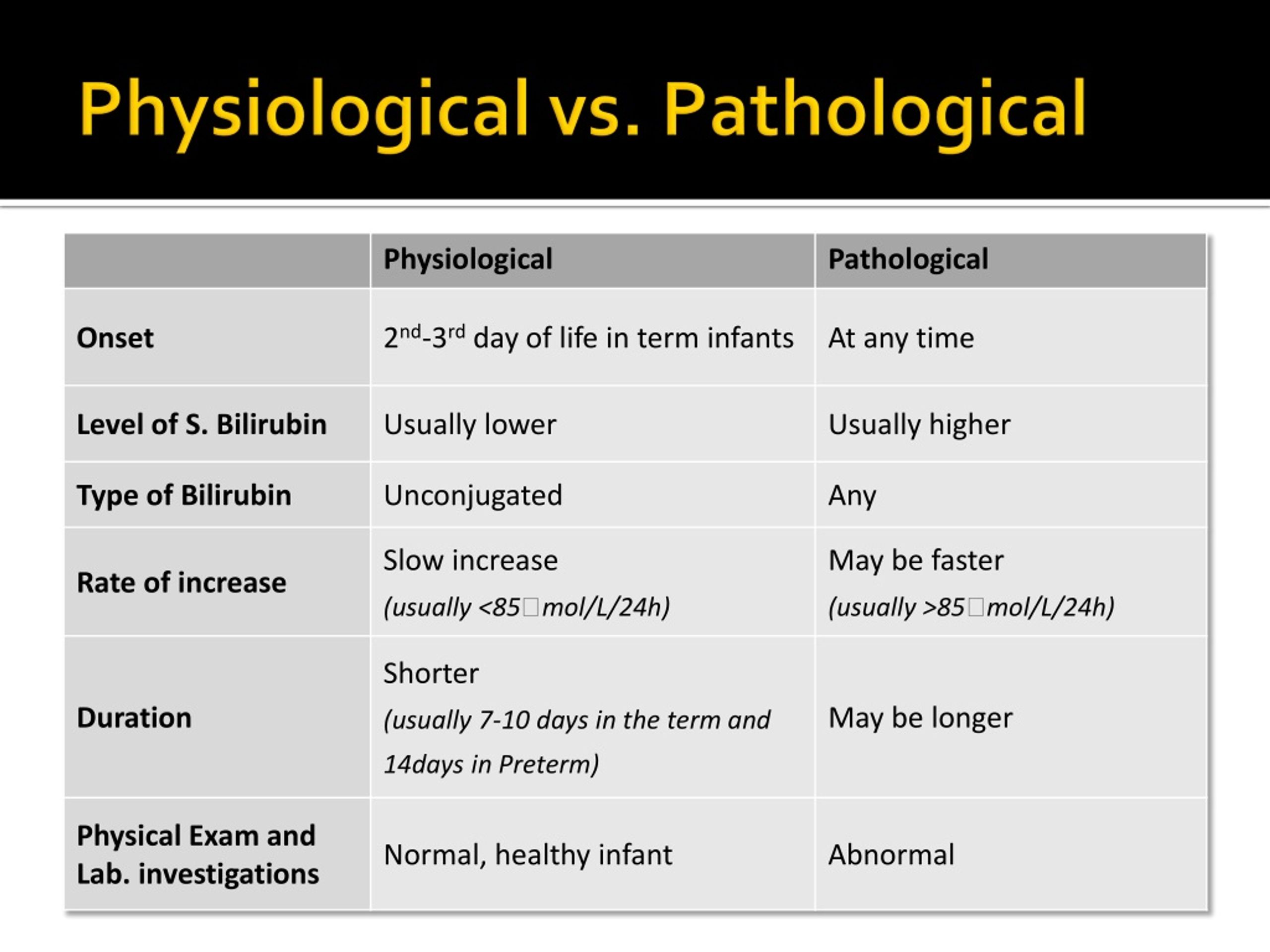
Therapy and medication are the two main treatments for anxiety. If you experience physical symptoms, talk therapy or medication that improves your anxiety often leads to improvement of these symptoms.
Cognitive behavioral therapy (CBT) is one of the most common and effective therapy options for anxiety.
You may find that therapy on its own is helpful. But if your symptoms don’t improve, anxiety medication is an option you can discuss with a psychiatrist.
You can also take action on your own to address anxiety symptoms.
Self-Care For Anxiety
- Be physically active, if you’re able: Exercise can help reduce stress and improve physical health. If you can’t be active, try sitting outside every day. Research increasingly shows that nature can benefit mental health.
- Avoid alcohol, caffeine, and nicotine: Any of these can make anxiety worse.
- Try relaxation techniques: Guided imagery and deep breathing are two practices that can help your body relax.
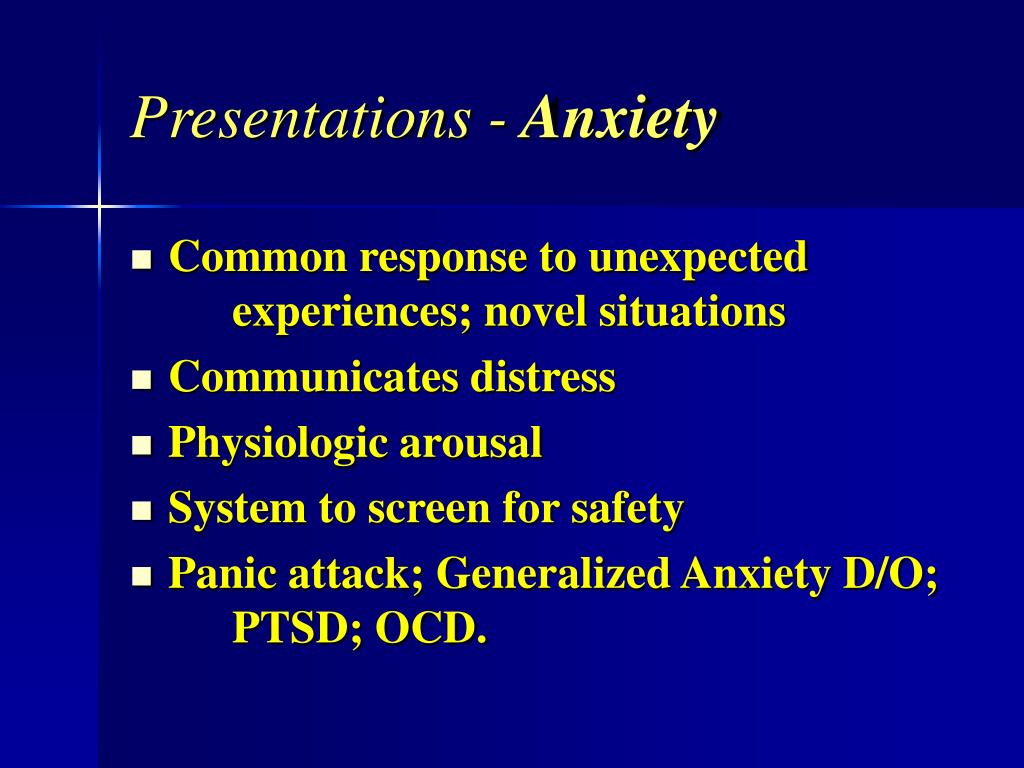 Meditation and yoga can also benefit you. These techniques are considered safe, but it is possible to experience increased anxiety as a result.
Meditation and yoga can also benefit you. These techniques are considered safe, but it is possible to experience increased anxiety as a result. - Prioritize sleep: Sleep issues often accompany anxiety. Try to get as much sleep as you can. Feeling rested can help you cope with anxiety symptoms. Getting more sleep could also reduce symptoms.
What are some common signs of anxiety?
When you feel anxious you might have racing thoughts but also physical symptoms, such as difficulty breathing, tense muscles, trembling, a rapid heartbeat, and pain and bloating in your abdomen. These are all the results of the stress response when the body releases cortisol as it prepares for “fight or flight.”
What causes anxiety?
The causes vary widely between individuals. Possible triggers include public speaking, a confrontation, illness, work, driving on a fast road, or a high-profile event, such as a wedding. Some people become anxious for no apparent reason, which may be a sign of an anxiety disorder.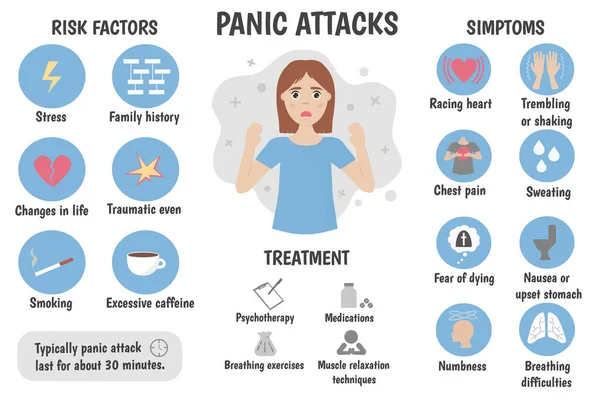
How can I stop anxiety?
Deep breathing can help you calm down at the time anxiety happens. Other techniques include visualization, meditation, and yoga. Getting enough exercise and sleep can also help in the long term. If anxiety is hard to manage, a doctor may recommend counseling, medication, or both.
Persistent fear and worry are fairly well-known anxiety symptoms, but you may be less familiar with anxiety’s physical symptoms. You may be unaware what you’re experiencing is anxiety.
Untreated anxiety can have long-term effects for all areas of health. Talk to your doctor if your symptoms persist or cause difficulty for you at work or school, or in your relationships.
There’s no cure for anxiety, but treatment, which often includes a combination of therapy and medication, is often very helpful at reducing symptoms.
What Does It Feel Like?
If you have anxiety, you might frequently feel worried, nervous, or afraid about ordinary events. These feelings can be upsetting and difficult to manage.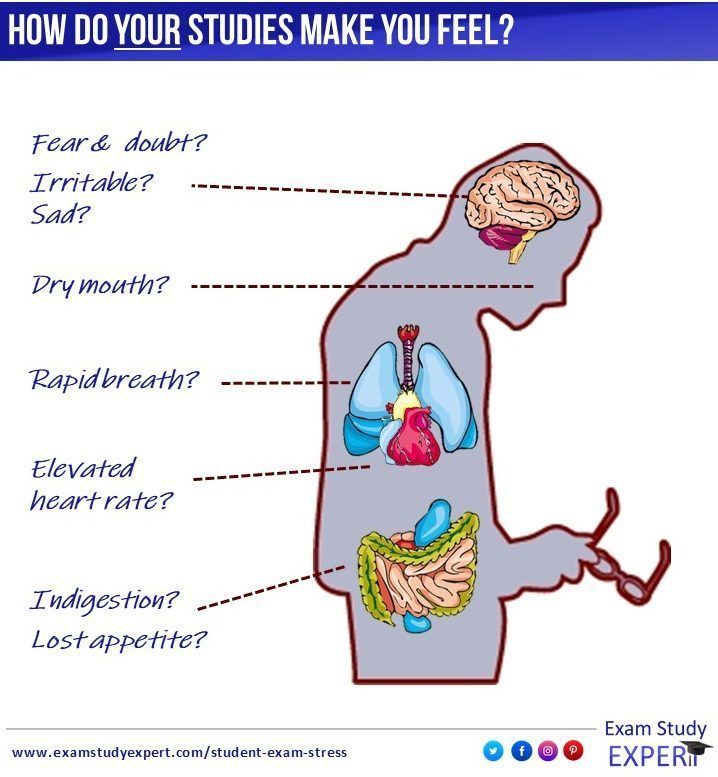 They can also make daily life a challenge.
They can also make daily life a challenge.
Anxiety can also cause physical symptoms. Think about a time when you felt anxious. Maybe your hands were sweaty or your legs were shaky. Your heart rate might have sped up. You could have felt sick to your stomach.
You might have linked these symptoms to your nervousness. But maybe you weren’t sure why you felt unwell.
Most people experience anxiety on occasion. Anxiety can be serious or turn into a disorder if it lasts for a long time, causes significant distress, or interferes with your life in other ways.
Types of anxiety include:
- panic disorders
- generalized anxiety disorder (GAD)
- separation anxiety
- social anxiety
- phobias
- obsessive-compulsive disorder (OCD)
Some types of anxiety have unique symptoms specific to the fears linked to the anxiety. In general, though, anxiety disorders share many physical symptoms.
Read on to learn more about anxiety’s physical symptoms and how they can affect you.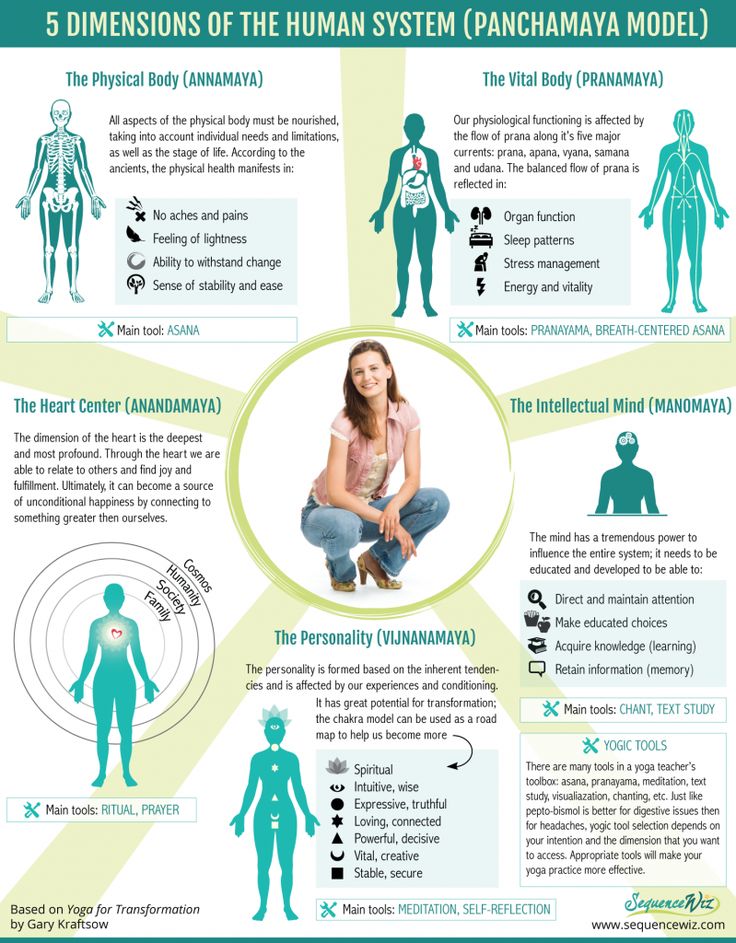
Anxiety can have physical symptoms that affect health and daily life.
Physical symptoms of anxiety
- stomach pain, nausea, or digestive trouble
- headache
- insomnia or other sleep issues (waking up frequently, for example)
- weakness or fatigue
- rapid breathing or shortness of breath
- pounding heart or increased heart rate
- sweating
- trembling or shaking
- muscle tension or pain
Specific types of anxiety might have additional physical symptoms.
If you’re having a panic attack, you might:
- fear that you’re going to die
- have trouble breathing or feel as if you’re choking
- have numb or tingling sensations in parts of your body
- have chest pain
- feel lightheaded, dizzy, or as if you might pass out
- feel overheated or have chills
Anxiety, the body’s response to stress, is how your body alerts you to threats and helps you get ready to deal with them.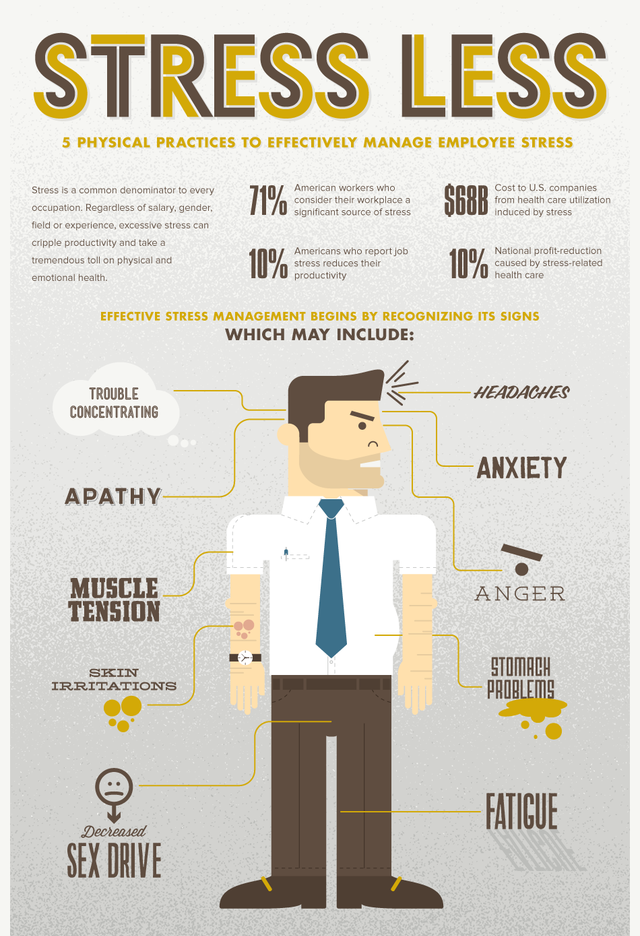 This is called the fight-or-flight response.
This is called the fight-or-flight response.
When your body responds to danger, you breathe rapidly because your lungs are trying to move more oxygen through your body in case you need to escape. This can make you feel as if you’re not getting enough air, which could trigger further anxiety or panic.
Your body isn’t meant to always be on alert. Being in constant fight-or-flight mode, which can happen with chronic anxiety, can have negative and serious effects on your body.
Tensed muscles may prepare you to get away from danger quickly, but muscles that are constantly tense can result in pain, tension headaches, and migraines.
The hormones adrenalin and cortisol are responsible for increased heartbeat and breathing, which can help when facing a threat. But these hormones also affect digestion and blood sugar.
If you’re often stressed or anxious, frequently releasing these hormones can have long-term health effects. Your digestion may also change in response.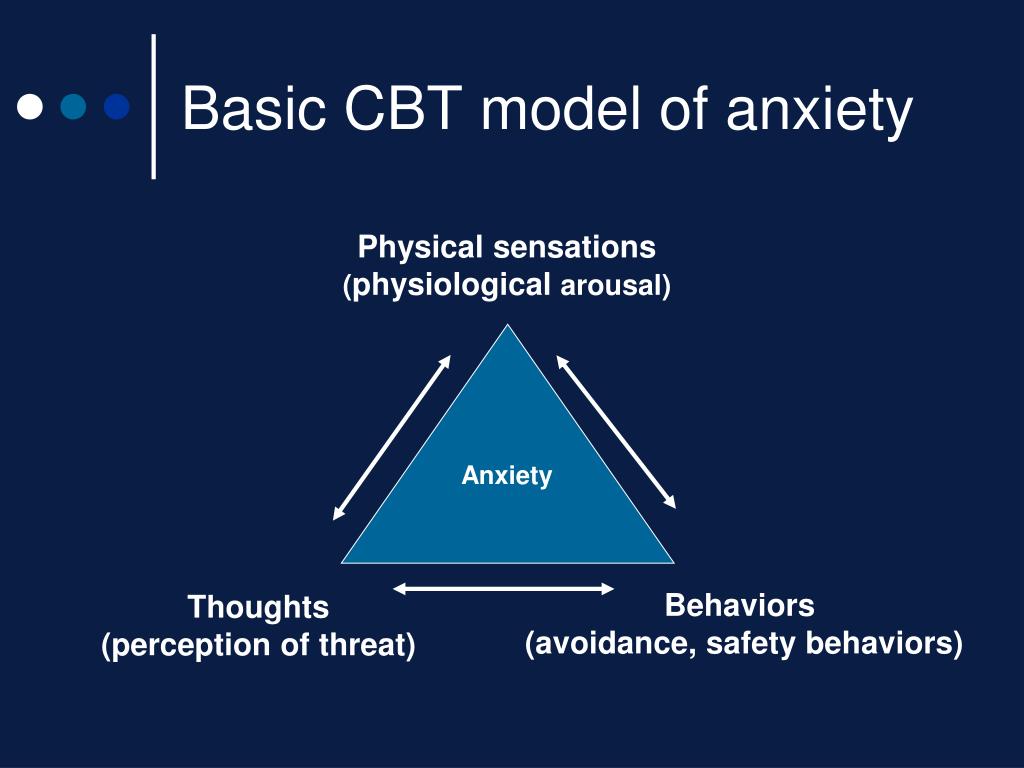
If your symptoms affect your mental health or make everyday life difficult, it’s a good idea to see a doctor. Your primary care provider can rule out medical issues that cause the same symptoms.
If your physical symptoms have no medical cause, you could have anxiety. A mental health professional can diagnose anxiety and other mental health conditions.
While there’s no medical test for anxiety, there are screening tools a psychiatrist, psychologist, therapist, or counselor may use to help determine if you have anxiety.
A mental health professional will ask you about all of your symptoms, physical and emotional, to determine whether you have an anxiety disorder. They’ll also want to know how long you’ve had symptoms and if they’ve increased in severity or were triggered by a specific event.
There are important facts to share with your therapist:
- Are you using drugs or other substances?
- Have you been hurting yourself or are you having thoughts of hurting yourself or others?
Either of these things can impact diagnosis and treatment.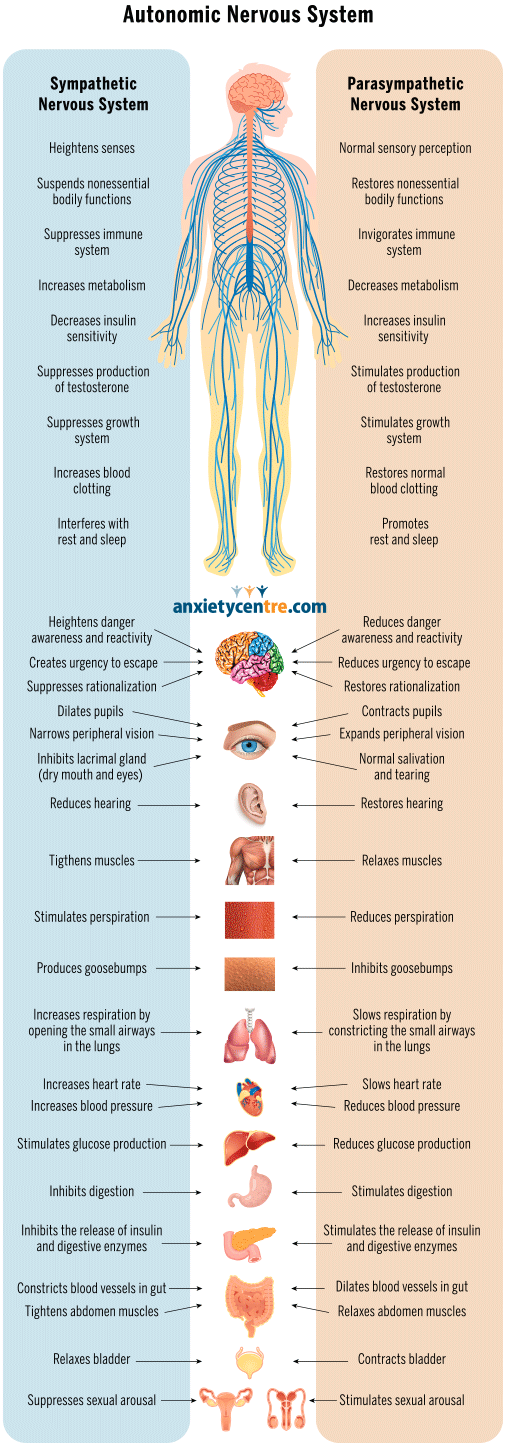 Many people have anxiety along with another mental health condition, such as depression. Telling your therapist about all of your symptoms can help you get the most accurate diagnosis and most helpful treatment.
Many people have anxiety along with another mental health condition, such as depression. Telling your therapist about all of your symptoms can help you get the most accurate diagnosis and most helpful treatment.
According to the Anxiety and Depression Association of America (ADAA), you may be at increased risk for physical health problems if you have anxiety.
A 2015 study of 989 adults found that anxiety symptoms were associated with ulcers. The same study also found that as anxiety and depression symptoms increased, it became more likely a person would have:
- asthma
- heart problems
- migraines
- vision problems
- back problems
Research has further linked asthma and anxiety. A 2016 study suggested that either asthma or anxiety can cause or result from the other.
Research has also suggested that anxiety is associated with an increased risk for heart disease, heart failure, and stroke, though it hasn’t been determined that anxiety is a specific risk factor for these conditions.
A 2017 study of older adults found that anxiety was associated with heart disease. Having both anxiety and depression was linked to an increase in vision problems, stomach problems, and asthma, among other issues.
Because anxiety can have such a serious impact on health, it’s important to get help. Mild anxiety may go away on its own or after the event causing the anxiety is over, but chronic anxiety often persists and may get worse.
If you aren’t sure how to find a therapist, you can ask your primary care provider for a referral.
Therapist directories can also help you locate a therapist in your area. If you think you have anxiety, you can look for providers who specialize in anxiety treatment.
Finding Help For Anxiety
- ADAA Online Support Group
- Crisis Text Line: Text CONNECT to 741741
- SAMHSA: Help finding treatment in your area
- ADAA therapist directory
Treatment for anxiety depends on what symptoms you have and how severe they are.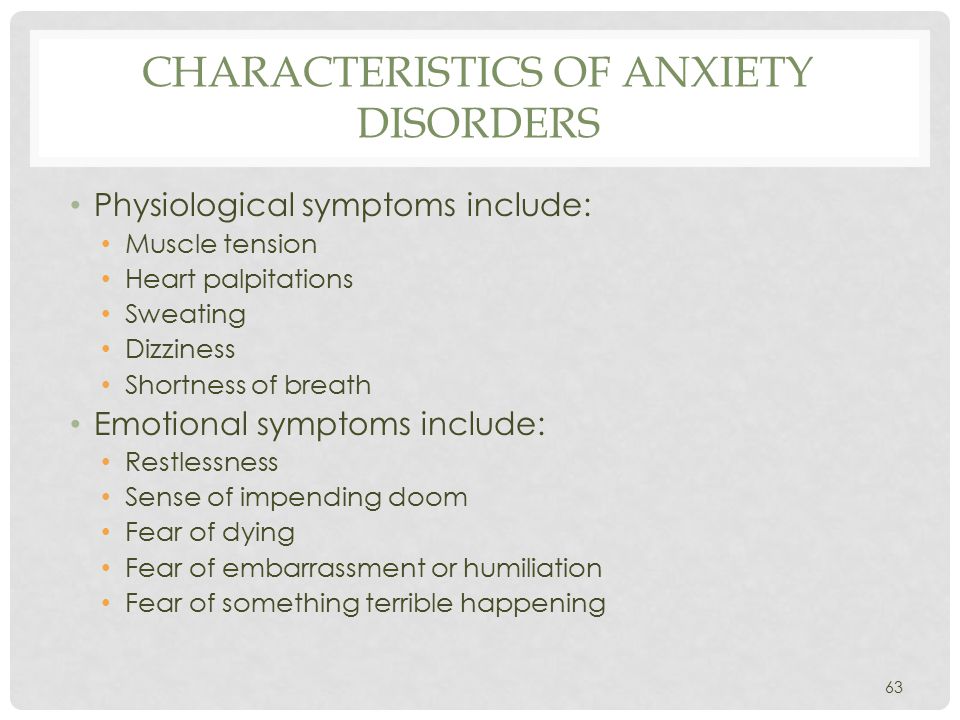
Therapy and medication are the two main treatments for anxiety. If you experience physical symptoms, talk therapy or medication that improves your anxiety often leads to improvement of these symptoms.
Cognitive behavioral therapy (CBT) is one of the most common and effective therapy options for anxiety.
You may find that therapy on its own is helpful. But if your symptoms don’t improve, anxiety medication is an option you can discuss with a psychiatrist.
You can also take action on your own to address anxiety symptoms.
Self-Care For Anxiety
- Be physically active, if you’re able: Exercise can help reduce stress and improve physical health. If you can’t be active, try sitting outside every day. Research increasingly shows that nature can benefit mental health.
- Avoid alcohol, caffeine, and nicotine: Any of these can make anxiety worse.
- Try relaxation techniques: Guided imagery and deep breathing are two practices that can help your body relax.
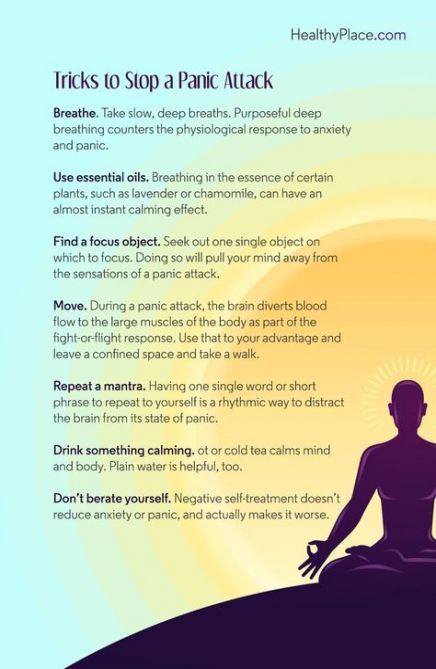 Meditation and yoga can also benefit you. These techniques are considered safe, but it is possible to experience increased anxiety as a result.
Meditation and yoga can also benefit you. These techniques are considered safe, but it is possible to experience increased anxiety as a result. - Prioritize sleep: Sleep issues often accompany anxiety. Try to get as much sleep as you can. Feeling rested can help you cope with anxiety symptoms. Getting more sleep could also reduce symptoms.
What are some common signs of anxiety?
When you feel anxious you might have racing thoughts but also physical symptoms, such as difficulty breathing, tense muscles, trembling, a rapid heartbeat, and pain and bloating in your abdomen. These are all the results of the stress response when the body releases cortisol as it prepares for “fight or flight.”
What causes anxiety?
The causes vary widely between individuals. Possible triggers include public speaking, a confrontation, illness, work, driving on a fast road, or a high-profile event, such as a wedding. Some people become anxious for no apparent reason, which may be a sign of an anxiety disorder.
How can I stop anxiety?
Deep breathing can help you calm down at the time anxiety happens. Other techniques include visualization, meditation, and yoga. Getting enough exercise and sleep can also help in the long term. If anxiety is hard to manage, a doctor may recommend counseling, medication, or both.
Persistent fear and worry are fairly well-known anxiety symptoms, but you may be less familiar with anxiety’s physical symptoms. You may be unaware what you’re experiencing is anxiety.
Untreated anxiety can have long-term effects for all areas of health. Talk to your doctor if your symptoms persist or cause difficulty for you at work or school, or in your relationships.
There’s no cure for anxiety, but treatment, which often includes a combination of therapy and medication, is often very helpful at reducing symptoms.
Physiological causes of anxiety | Anima Clinic Articles
Physiological Causes of Anxiety | Anima clinic articles st.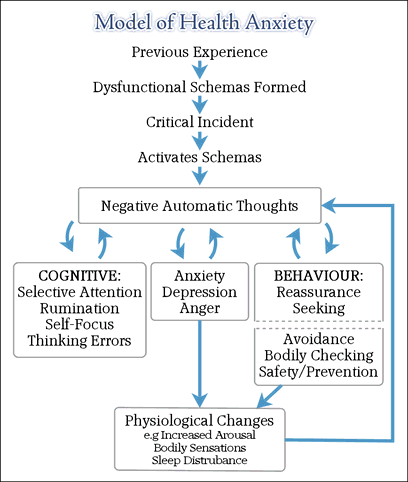 Kirova, 27/3 +7 (383) 383-6-333
Kirova, 27/3 +7 (383) 383-6-333
st. Family Shamshin, 30 +7 (383) 383-6-333
st. Ivanova 8 +7 (383) 383-6-333
Anxiety is a feeling found in various mental disorders. But there are somatic, that is, physical causes that contribute to the occurrence of increased anxiety. Let's consider the most characteristic of them.
Causes of anxiety
- Diseases of the thyroid gland, in particular hyperthyroidism - a condition in which the thyroid gland produces an excessive amount of hormones. The causes of this condition can be both in "malfunctions" at the level of the gland itself, and at the level of higher centers of endocrine regulation - the pituitary gland and hypothalamus. Anxiety in thyroid disease, as well as irritability, pathological distractibility, mild memory impairment can be so pronounced that they resemble the clinical picture of an anxiety disorder, less often - mania or depression.
- Diseases of the adrenal glands, in particular pheochromocytoma - a tumor of the adrenal glands, leading to an increased level of catecholamines - hormones of the adrenal medulla (localization can also be extra-adrenal) - adrenaline and norepinephrine.
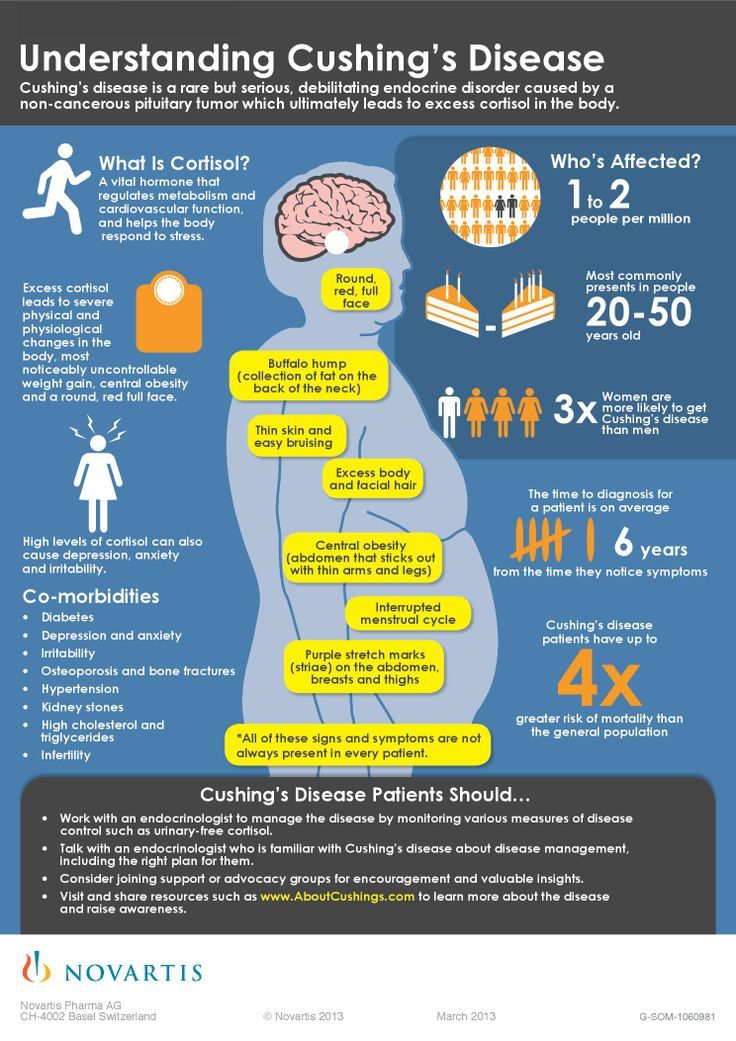 This hormonal imbalance leads to a paroxysmal course of the disorder - attacks are characterized by sharp increases in blood pressure, severe anxiety, trembling, chills, pallor of the skin, headache, pain behind the sternum, in the heart area, tachycardia, nausea, fever, sweating, dry mouth . These manifestations resemble a panic attack.
This hormonal imbalance leads to a paroxysmal course of the disorder - attacks are characterized by sharp increases in blood pressure, severe anxiety, trembling, chills, pallor of the skin, headache, pain behind the sternum, in the heart area, tachycardia, nausea, fever, sweating, dry mouth . These manifestations resemble a panic attack. - Diabetes mellitus is a disease associated with an increase in blood glucose levels due to absolute or relative insufficiency of insulin and its effect on body tissue cells. With this disease (both types 1 and 2), anxiety, restlessness, depression, and mood swings can be observed along with other specific symptoms.
- Pituitary adenoma - a disease characterized by the presence of a pituitary tumor, which, in turn, can lead to various disorders of the endocrine glands - adrenal glands, thyroid gland, gonads, etc.
This list is far from exhaustive, some, for example, neurological, autoimmune diseases, may also have symptoms of anxiety in their clinical picture.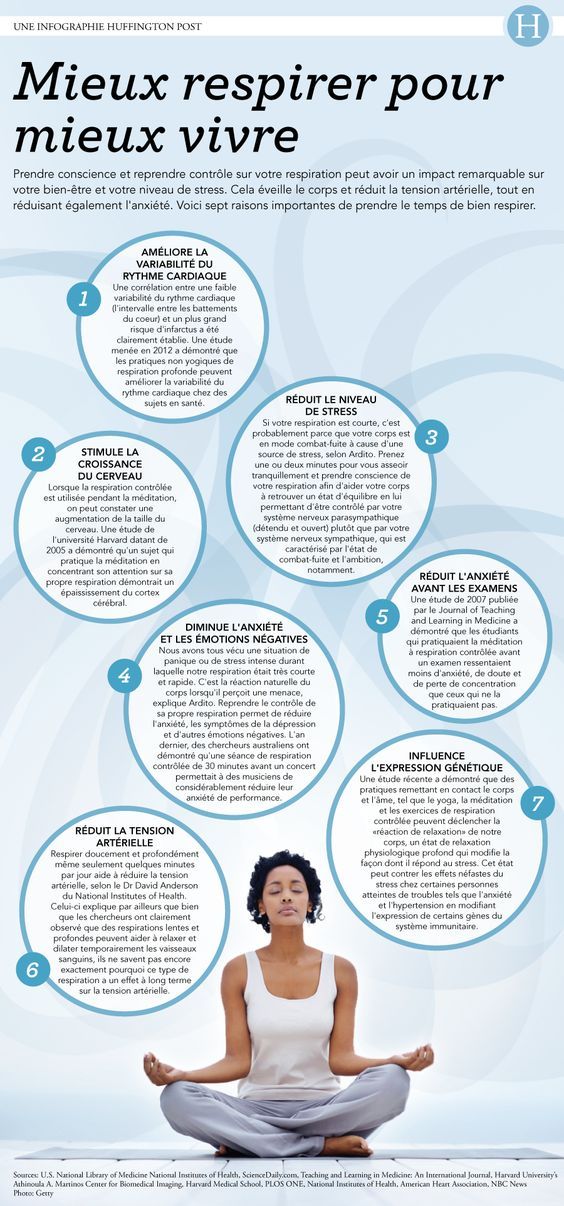
Physical and emotional state
It is important to know that long-term physical ailments can lead to the development of mental anxiety disorder and, conversely, long-term anxiety disorder can aggravate the course of somatic pathology. That is why at large multidisciplinary clinics there is a consultant on staff - a psychiatrist, psychotherapist or psychologist.
When interviewing and examining a patient with an anxiety disorder, the psychiatrist of the Anima clinic may also detect the likely presence of somatic pathology - in this case, a consultation with a doctor of another specialty will be required.
Publication date: 10/09/2020
Updated: 11/08/2022
popular Articles
All clinic articles
7 physical symptoms of anxiety | PSYCHOLOGIES
Everyone can name a few physical signs of anxiety:
- chills or trembling;
- redness of the skin;
- excessive sweating;
- nausea;
- palpitations.
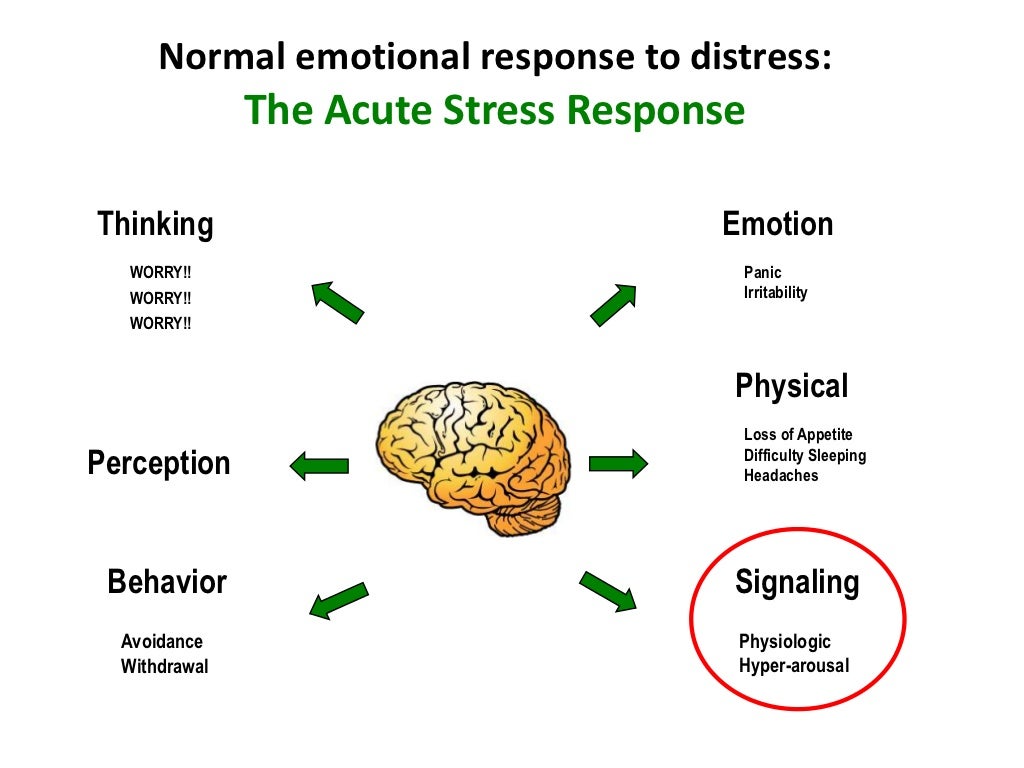
However, those who suffer from a chronic anxiety disorder, including panic attacks, phobias, general or social anxiety, experience more persistent symptoms, even when there is no reason to worry.
These conditions are so similar to serious illnesses that many do not realize their true nature. Instead, they worry that they have a bad heart, chronic migraines, or other health problems. Accordingly, anxiety develops into neurosis and prolonged stress.
1. Dizziness
A person falls into a semi-conscious state, as if the ground is slipping from under his feet and he is about to fall. Most often this happens in a crowd or in an open space. People get anxious as soon as they feel a little dizzy. They are afraid to stumble, fall or lose consciousness in a public place, which makes their head spin even more and anxiety increases.
These fears often develop into a desire to avoid anything that can trigger the symptom, including physical activity and strong experiences.
2. Chest pain
Acute chest pain when frightened or shocked, usually accompanied by rapid heartbeat and shortness of breath. Similar sensations occur during a heart attack, so many fear for their lives. They call an ambulance and get annoyed with the doctors when they do not find clinical signs of a heart disease.
Meanwhile, in a survey of 150 patients with complaints of chest pain, 59% of them revealed signs of an anxiety disorder. Another study found that people who suspected they had a heart attack were much more likely to have anxiety than heart disease.
3. Headache
Tension headache or "tension headache" and migraines often indicate an anxiety disorder, although the primary factors vary.
- Sleep disorders. Most often, insomnia and other sleep problems occur against the background of nervous tension: anxious people constantly do not get enough sleep, which can provoke a migraine.
- Lack of serotonin.
 This neurotransmitter regulates our emotional state. With its deficiency, mental disorders develop, including anxiety. When the level of serotonin drops sharply, the vessels constrict, and the head starts to hurt.
This neurotransmitter regulates our emotional state. With its deficiency, mental disorders develop, including anxiety. When the level of serotonin drops sharply, the vessels constrict, and the head starts to hurt. - General stress. In stressful situations, the muscles involuntarily contract, and if this condition is prolonged, the body responds with a headache. In addition, stress is considered the most common cause of migraines.
4. Digestive disorders
According to doctors, the reason lies in the fact that the intestines and the brain are connected by nerve fibers. The alarm signal instantly enters the gastrointestinal tract and manifests itself in somatic diseases. Nervous or worried, many feel a flutter in the stomach or mild nausea.
However, chronic anxiety manifests itself in more serious ailments:
- abdominal cramps;
- diarrhea or vomiting;
- constipation;
- appetite disorders;
- peptic ulcer;
- irritable bowel syndrome.

Fears that vomiting or diarrhea may occur in public are morally depressing and increase anxiety. Moreover, prolonged dysfunction of the gastrointestinal tract not only interferes with a normal life, but also leads to severe personality disorders.
5. Difficulty breathing
Difficulty breathing when anxious. This manifests itself in many ways: from hyperventilation and accelerated breathing to suffocation and lack of air. Usually these symptoms are unstable. They can be repeated in tense situations, with danger or nervous excitement. For example, during a panic attack, people often feel as if they have forgotten how to breathe. Such sensations are very frightening and aggravate the anxiety disorder.
6. Numbness of limbs
Anxious people describe this sensation as tingling in numb hands, forearms, calves and feet. Thus the body reacts to the general overexcitation. In response to a threat, the body redistributes resources: blood drains from the limbs and rushes to more important organs, such as the heart.